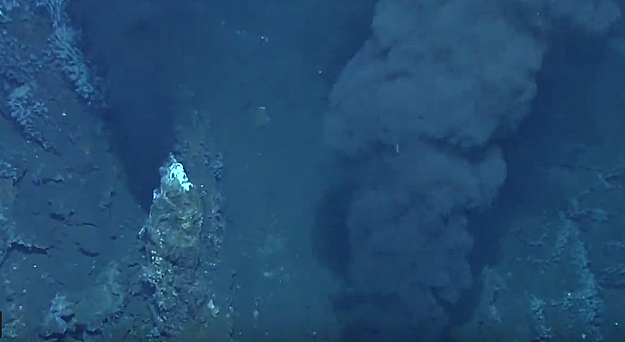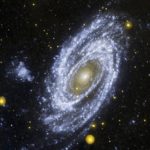Contributed by Arthur P. Omran Jr., University of South Florida
Cite as: Omran, A. (2021) “We Need not a Crusade for the Origins of Life” Primordial Scoop, 2021, e0606. https://doi.org/10.52400/MNEF3740.
The community studying the origins of life has its schisms. None seems to be more contentious than the schism separating those who hold that life arose on the surface in evaporating ponds on dry land, versus those who hold that life arose in deep sea vents. Recently, one group of “land-lovers”, working in Cambridge not far from the Archbishop of Canterbury, have become aggressive.
John Sutherland’s favorite model for origins requires not only intermittently dry land above ocean flooding, but also strong ultraviolet radiation from a Sun above, to generate electrons to reduce things. Sutherland’s faith is strong, driving him to suggest that “the idea that life originated at vents should, like the vents themselves, remain ‘in the deep bosom of the ocean buried’.” For those not having an Oxford education, the quotation is Shakespeare, Richard III.
Mike Russell objected (1) to Sutherland’s “speaking ex cathedra“. No conclave elected Sutherland Pope, although Sutherland does preside over the Simons Collaboration on the Origins, a large source of funding in the field. Russell joined with Elbert Branscomb to point out that strong “UV photons [have] the cost of exposing a tender and unprotected neonatal metabolism to destructive radiation.” Nick Lane dissected Sutherland’s model (2), replacing harsh UV light by gentler mineralogic sources of electrons found in abundance in … hydrothermal vents.
Matt Pasek and I recently published a view (3) that suggests that a crusade to punish the heathens, by either side, is premature. These environments may have had more in common than in difference.
Further, while Russell provided me my own interest in vents, and deserves credit for having moved the field forward, many who work with submarine hydrothermal vent theories have different thoughts on how vent chemistry may have formed life. Russell is likewise not the Pope of Vents. Many new studies have emerged. Consider the different chemistries other vent theorists have been working on:
• Alkaline vents are a plausible local for the formose reaction. Moreover, the formose reaction is a messy way to get metabolic acids/proto-metabolism under alkaline conditions (4,5).
• Impressive complex systems interactions of rocks/minerals and organics, understanding the effects organics have on inorganics and vice versa (6,7).
• Lipid chemistry in an oceanic context shows that deep sea theories can incorporate fatty acids (8,9).
• Possible oxidative phosphorylation pathways exist for icy and rocky worlds (10).
• Advances in understanding the source of reactants by reducing CO2 (11) and showing links to metabolism (12).
• Impressive concentration mechanisms in the deep-sea hydrothermal sediments (13).
Many vent theorists are civil conversationalists who admit that vent views do not reflect a majority opinion, and certainly are not a “new modus operandi”(14). But many modern versions of the hydrothermal vent hypothesis need consideration.
Life has many definitions. Much we do not know. Our understanding of the early Earth is incomplete. And it remains unclear if life emerged only once and can emerge in only one way.
For example, some land-lover models allow RNA to emerge on the surface without needing any harsh UV light. Further, worlds in our Solar System exist without obvious opportunities for wet-dry cycles, such as the icy moons of Jupiter and Saturn. It is imperative that we as a community do not ex cathedra discard the hydrothermal vent hypothesis, if only because on hydrothermal vents may play a crucial role in establishing biospheres on these ocean worlds. And one reason to argue that life on Earth did not originate on dry land comes from the view that Earth itself at the relevant time was a “water world” (15).
We need not choose one way or one environment for life’s emergence. Dry-land theories and deep-sea theories need not be in direct competition. Who can deny the power of wet-dry cycles to synthesize biopolymers? Who can deny the power of minerals to provide electrons? And do we not all need to find some way to exploit the “messy chemistry” (5) that seems to accompany a great many origins models?
Or panspermia. What if life took hold on the surface of Mars and retreated to Earth when it needed more water?
Bio
Arthur Omran has a Ph.D. in Chemistry, he is currently doing postdoctoral work with Matt Pasek on the origins of life. Previously he studied to be a Catholic priest. He will begin as a visiting professor in the Department of Chemistry at the University of North Florida starting in August.
References
1. Branscomb, E., & Russell, M. J. (2018) Frankenstein or a Submarine Alkaline Vent: Who is Responsible for Abiogenesis? Bioessays 40, 1700182
2. Lane, N. (2017) Proton gradients at the origin of life. BioEssays, 39(6), 1600217.
3. Omran, A., & Pasek, M. (2020) A Constructive Way to Think about Different Hydrothermal Environments for the Origins of Life. Life, 10(4), 36.
4. Omran, A. (2020) Plausibility of the Formose Reaction in Alkaline Hydrothermal Vent Environments. Origins of Life and Evolution of Biospheres, 1-13.
5. Omran, A., Menor-Salvan, C., Springsteen, G., & Pasek, M. (2020) The Messy Alkaline Formose Reaction and Its Link to Metabolism. Life, 10(8), 125.
6. Flores, E., Martinez, E., Rodriguez, L.E., Weber, J.M., Khodayari, A., VanderVelde, D.G. & Barge, L.M., (2021) Effects of Amino Acids on Phosphate Adsorption Onto Iron (Oxy) hydroxide Minerals under Early Earth Conditions. ACS Earth and Space Chemistry.
7. Weber, J.M. & Barge, L.M., (2021) Iron‐Silicate Chemical Garden Morphology and Silicate Reactivity with Alpha‐Keto Acids. ChemSystemsChem, 3(3), p.e2000058.
8. Jordan, S.F., Rammu, H., Zheludev, I.N., Hartley, A.M., Maréchal, A. & Lane, N., (2019) Promotion of protocell self-assembly from mixed amphiphiles at the origin of life. Nature ecology & evolution, 3(12), 1705-1714.
9. Jordan, S.F., Nee, E. and Lane, N., (2019) Isoprenoids enhance the stability of fatty acid membranes at the emergence of life potentially leading to an early lipid divide. Interface focus, 9(6), 20190067.
10. Rodriguez, L.E., Barge, L.M., Major, J., Pasek, M.A. & Vander Velde, D., (2020), March. Phosphorus Redox Geochemistry on Rocky Worlds: Exploring Phosphite Oxidation and Organic Phosphorylation Catalyzed by Iron and Manganese Oxyhydroxides. In Lunar and Planetary Science Conference (No. 2326, p. 1667).
11. Hudson, R., de Graaf, R., Rodin, M.S., Ohno, A., Lane, N., McGlynn, S.E., Yamada, Y.M., Nakamura, R., Barge, L.M., Braun, D. & Sojo, V., (2020) CO2 reduction driven by a pH gradient. Proceedings of the National Academy of Sciences, 117(37), 22873-22879.
12. Weber, J.M. & Barge, L.M. (2021, March) Exploring the Reactivity of Metabolically Relevant Precursors Under Hydrothermal Analog Settings. In Lunar and Planetary Science Conference (No. 2548, p. 1146).
13. Westall, F., Hickman-Lewis, K., Hinman, N., Gautret, P., Campbell, K. A., Bréhéret, J. G., … & Kee, T. P. A (2018) Hydrothermal-sedimentary context for the origin of life. Astrobiology 18(3), 259-293.
14. Powner, M. W., & Sutherland, J. D. (2011) Prebiotic chemistry: A new modus operandi. Philosophical Transactions of the Royal Society B: Biological Sciences, 366(1580), 2870-2877.
15. Benner, S. A. (2021) “If Earth was a Water World, then we are Martians”. Primordial Scoop, 2021, e0313. https://doi.org/10.52400/WGOO7791



